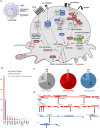Clinical and molecular findings in actin-related inborn errors of immunity: the middle East and North Africa registry
- PMID: 40860338
- PMCID: PMC12370701
- DOI: 10.3389/fgene.2025.1584681
Clinical and molecular findings in actin-related inborn errors of immunity: the middle East and North Africa registry
Abstract
Background: The majority of monogenic inborn errors of immunity presenting as actinopathies were reported originally from the Middle East and North Africa (MENA) countries indicating a high prevalence of these entities in the region. However, their prognosis is unclear due to rarity and lack of comprehensive treatment outcomes.
Methods: We evaluated clinical, immunological, and genetic abnormalities associated with 15 genetic entities of actinopathies. Based on the function of mutant genes in actin-regulatory pathways, patients were classified into CDC42- and RAC2-related subcategories.
Results: A total of 503 individuals (29.5% females) from 17 countries were considered with a median age of 120 months. Although most patients presented initially with allergic phenotypes (37.7%), the most prevalent manifestations throughout the lifespan were infection in respiratory tracts (72.2%). Primary clinical diagnosis was mainly combined immunodeficiencies (48.3%) and the majority of cases were molecularly assigned to the CDC42 pathway (64.8%). The most common genetic defects were reported within the DOCK8 (n = 209) followed by the WAS (n = 94) and the CARMIL2 (n = 15) genes. Hematopoietic stem cell transplantation (HSCT) was conducted on 24.0% of patients, which significantly improved survival in patients with defects in WAS, DOCK8 and DOCK2. Overall mortality was 23.0%, mainly due to sepsis and malignancy.
Conclusion: Patients with defects in RAC2-associated regulators of actin usually present with late-onset symptoms due to normal immune profiles, but a higher rate of EBV and HPV infections, autoimmune cytopenia, asthma, and lymphoproliferation compared to defects in the CDC42 pathway. The severity of mutations in patients of the CDC42 group helps to estimate the prognosis of the disease and prioritization of HSCT.
Keywords: actinopathies; eosinophilia; genetic; immune dysregulation; inborn errors of immunity; primary immunodeficiency; thrombocytopenia.
Copyright © 2025 Chavoshzadeh, Fallah, Zeinali, Sharafian, Delavari, Mesdaghi, Djidjik, Belaid, Ikinciogullari, Haskologlu, Dogu, Genel, Gulez, Baris, Ozen, Karakoc-Aydiner, Kiykim, Meric, Kutukculer, Aygun, Aksu, Karaca, Geyik, Keles, Reisli, Nail Guner, Boukari, Hakem, Belbouab, Barbouche, Ben-Mustapha, Mekki, Ben-Ali, Sobh, Elnagdy, Djenouhat, Tahiat, Shendi, Alkuwaiti, Nasrullayeva, Alfars, Alsukaiti, Massaad, Mehawej, Megarbane, Irani, Elghazali, Al-Tamemi, Khalifa, Alzyoud, Gultekin, Kose, Khodaverdy, Shamsian, Eslami, Momen, Sherkat, Aleyasin, Esmaeilzadeh, Ahanchian, Salami, Fekrvand, Dupre, Ochs, Rezaei, Al-Herz and Abolhassani.
Conflict of interest statement
The authors declare that the research was conducted in the absence of any commercial or financial relationships that could be construed as a potential conflict of interest. The author(s) declared that they were an editorial board member of Frontiers, at the time of submission. This had no impact on the peer review process and the final decision.
Figures



References
LinkOut - more resources
Full Text Sources
Research Materials
Miscellaneous

